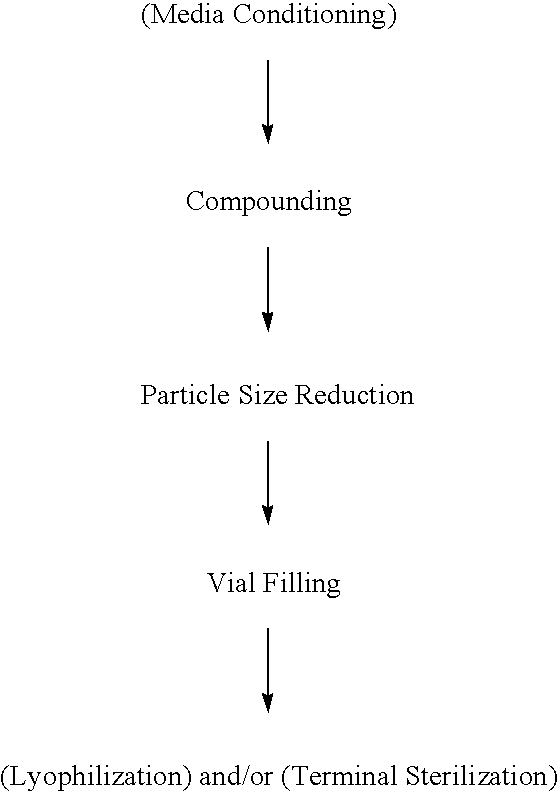Nanoparticulate corticosteroid and antihistamine formulations
a technology of nanoparticulate corticosteroids and formulations, which is applied in the field of nanoparticulate corticosteroids and antihistamine formulations, can solve the problems of impede the function of white blood cells, little evidence of any advantage of levocetirizine or desloratadine, and foreign bodies, and achieves the effect of less liver toxicity
- Summary
- Abstract
- Description
- Claims
- Application Information
AI Technical Summary
Benefits of technology
Problems solved by technology
Method used
Image
Examples
example 1
[0216] The purpose of this example was to prepare a nanoparticulate formulation of triamcinolone acetonide.
[0217] Triamcinolone acetonide drug substance (1.12 g) (PMRS) was combined with 8.95 g of a 5% hydroxypropylmethyl cellulose (HPMC) solution (Pharmacoat® 603; Shin-Etsu), 0.24 g of a 5% docusate sodium solution, and 12.08 g of sterile water for injection USP. The coarse slurry was milled in a NanoMill-01 machine (U.S. Pat. No. 6,431,478; Elan Drug Delivery (King of Prussia, Pa.)) equipped with a 50 mL chamber and containing 0.5 mm crosslinked polystyrene milling media (PolyMill-500; Dow Chemical) at 1333 rpm for 60 minutes (89% media load). During processing, chill water (approximately 5° C.) was circulated through the jacket of the mill chamber.
[0218] The final composition of the harvested dispersion was 5% triamcinolone acetonide, 2% HPMC, and 0.05% docusate sodium (all values w / w basis). The resulting dispersion had a mean triamcinolone acetonide particle size of 294 nm, w...
example 2
[0220] The purpose of this example was to prepare a nanoparticulate formulation of budesonide.
[0221] Budesonide drug substance (1.11 g) (Sicor Pharmaceuticals, Inc.) was combined with 0.13 g of polysorbate 80 and 21.40 g of sterile water for injection USP. The coarse slurry was milled in a NanoMill-01 machine equipped with a 50 mL chamber and containing 0.5 mm crosslinked polystyrene milling media (PolyMill-500; Dow Chemical) at 1333 rpm for 60 minutes (89% media load). During processing, chill water (approximately 5° C.) was circulated through the jacket of the mill chamber.
[0222] The final composition of the harvested dispersion was 5% budesonide, 0.5 polysorbate 80 (all values w / w basis). The resulting dispersion had a mean budesonide particle size of 287 nm with a D50 of 277 nm, a D90 of 389 nm, and a D95 of 437 nm. After 1 minute of sonication, the dispersion had a mean budesonide particle size of 327 nm, with a D50 of 318 nm, a D90 of 421 nm, and a D95 of 458 nm. Similar par...
example 3
[0224] The purpose of this example was to prepare a nanoparticulate formulation of fluticasone propionate.
[0225] Fluticasone propionate drug substance (1.12 g) (Dey Laboratories, Inc.) was combined with 8.95 g of a 5% povidone solution (Plasdone® K29-32; ISP), 0.23 g of a 5% sodium lauryl sulfate solution, and 12.09 g of sterile water for injection USP. The coarse slurry was milled in a NanoMill-01 machine equipped with a 50 mL chamber and containing 0.5 mm crosslinked polystyrene milling media (PolyMill-500; Dow Chemical) at 1333 rpm for 60 minutes (89% media load). During processing, chill water (approximately 5° C.) was circulated through the jacket of the mill chamber.
[0226] The final composition of the harvested dispersion was 5% fluticasone propionate, 2% povidone K29-32, and 0.05% sodium lauryl sulfate (all values w / w basis). The resulting dispersion had a mean fluticasone propionate particle size of 150 nm, with a D50 of 134 nm, a D90 of 251 nm, and a D95 of 298 nm. After ...
PUM
| Property | Measurement | Unit |
|---|---|---|
| Time | aaaaa | aaaaa |
| Percent by mass | aaaaa | aaaaa |
| Percent by mass | aaaaa | aaaaa |
Abstract
Description
Claims
Application Information
 Login to View More
Login to View More - R&D
- Intellectual Property
- Life Sciences
- Materials
- Tech Scout
- Unparalleled Data Quality
- Higher Quality Content
- 60% Fewer Hallucinations
Browse by: Latest US Patents, China's latest patents, Technical Efficacy Thesaurus, Application Domain, Technology Topic, Popular Technical Reports.
© 2025 PatSnap. All rights reserved.Legal|Privacy policy|Modern Slavery Act Transparency Statement|Sitemap|About US| Contact US: help@patsnap.com

